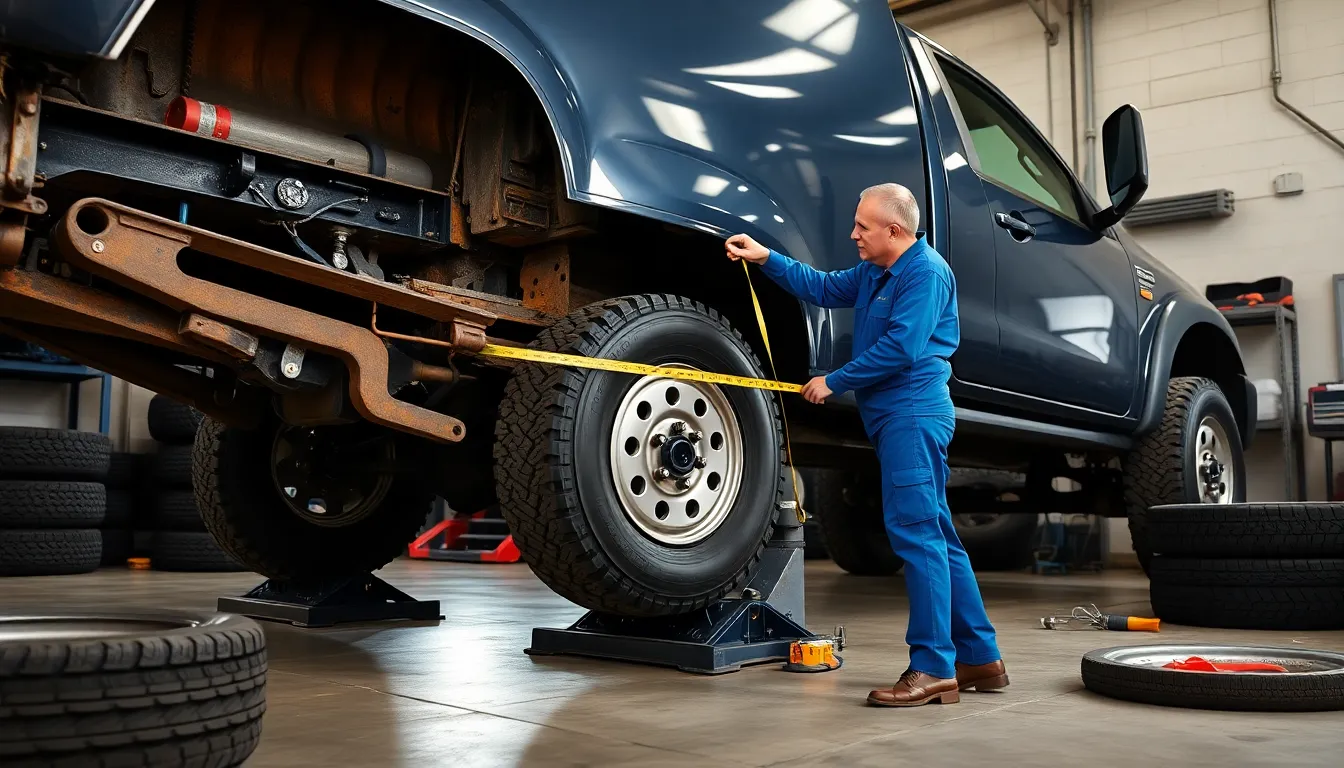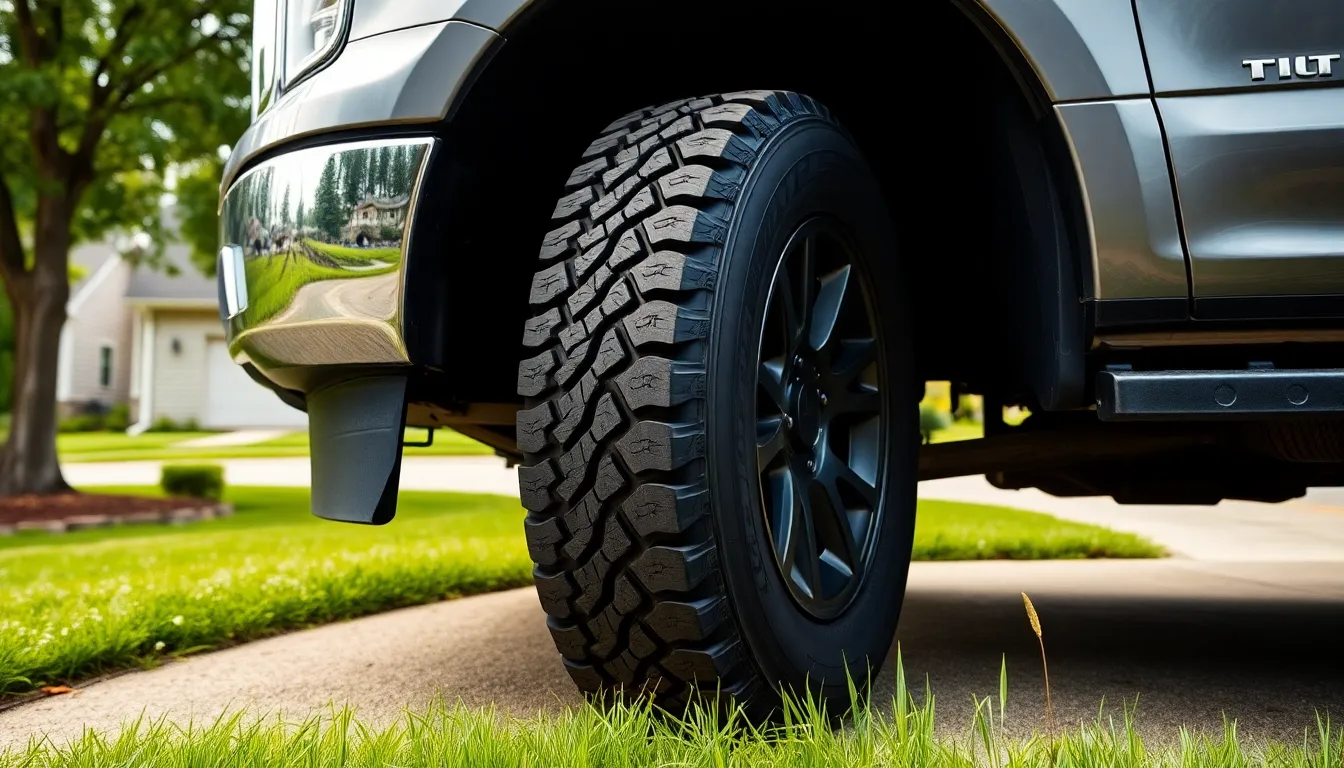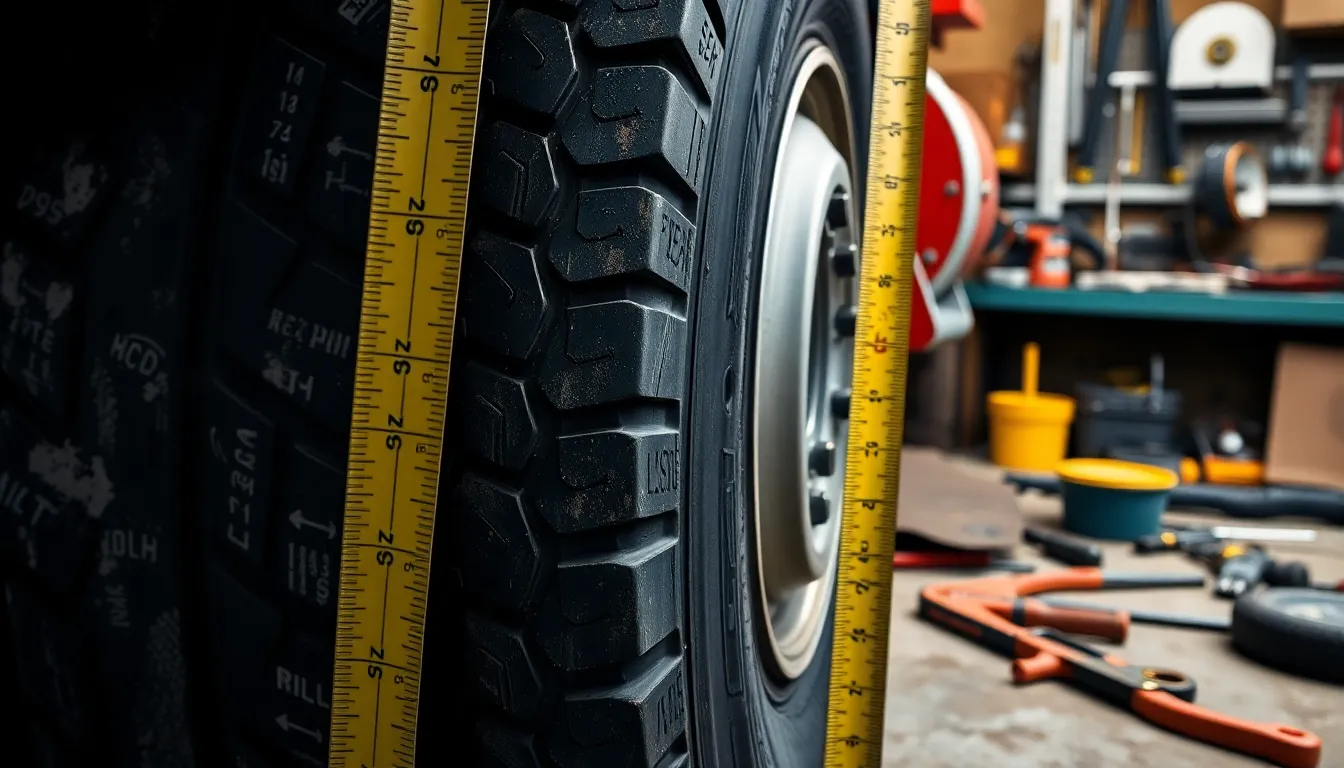Finding the right tire size for your truck can feel overwhelming with all the numbers and letters on sidewalls that look like secret codes. We’ve all stood in tire shops scratching our heads while trying to decode what those measurements actually mean for our exact vehicle.
Getting the wrong size isn’t just about looks – it affects your truck’s performance, fuel economy, and safety. Too small and you’ll lose ground clearance. Too large and you might face speedometer issues or clearance problems with your wheel wells.
We’ll walk you through everything you need to know about determining the perfect tire size for your truck. From reading your current tire sidewall to understanding load ratings and checking your owner’s manual, you’ll have the confidence to make the right choice for your driving needs and budget.
Understanding Your Truck’s Tire Size Requirements
Truck tire size requirements cover exact measurements and specifications that determine compatibility with your vehicle. The correct tire size ensures optimal performance, safety, and fuel efficiency for your truck.
Reading Your Current Tire Size
Current tire size information appears on the sidewall of your existing tires in a standardized format. We find the tire size displayed as a series of numbers and letters such as P265/70R16 or LT285/75R17.
The first letter indicates the tire type:
- P represents passenger vehicle tires
- LT designates light truck tires
- ST marks special trailer tires
The three digit number following the letter shows the tire width in millimeters. A tire marked 265 measures 265 millimeters across the tread from sidewall to sidewall.
The two digit number after the forward slash represents the aspect ratio as a percentage. This ratio compares the tire’s sidewall height to its width. A 70 aspect ratio means the sidewall height equals 70% of the tire’s width.
The letter R indicates radial construction, which describes how the tire’s internal layers are arranged. Most modern truck tires use radial construction for better fuel economy and handling.
The final number specifies the wheel diameter in inches. A tire ending in 16 fits a 16 inch wheel rim.
Locating Tire Information on Your Vehicle
Vehicle tire information exists in multiple locations beyond the tire sidewall itself. We recommend checking the driver’s side door jamb first, where manufacturers place a tire information placard.
The door jamb placard displays recommended tire sizes, inflation pressures, and load ratings for your exact truck model. This placard provides the most accurate tire size information because it matches your truck’s exact specifications from the factory.
Your owner’s manual contains detailed tire size charts organized by trim level and configuration. Different cab sizes, bed lengths, and drivetrain options often require different tire sizes on the same truck model.
The glove compartment sometimes houses additional tire information cards or booklets. These documents typically include seasonal tire recommendations and alternative size options approved by the manufacturer.
Some trucks display tire size information on a label inside the fuel door or on the spare tire cover. Newer trucks may include this information in the digital display system accessible through the dashboard menu.
How to Determine Compatible Tire Sizes

Determining compatible tire sizes for your truck requires checking multiple sources and measuring clearances to ensure proper fit. We recommend following a systematic approach to identify the best tire options for your exact vehicle.
Plus Sizing and Minus Sizing Options
Plus sizing increases the wheel diameter and width while maintaining the same overall diameter. This modification can improve handling characteristics but may affect ride quality due to reduced sidewall height. Websites like 1010Tires and Discount Tire offer calculators to compare sizes and visualize these changes.
Minus sizing decreases the wheel diameter and width to reduce cost and weight. This approach may affect traction performance but provides economic benefits for truck owners. Both sizing options require careful consideration of your truck’s intended use and driving conditions.
Maintaining Overall Diameter
Maintaining the original tire’s overall diameter ensures speedometer accuracy remains consistent. The new tire’s diameter must stay close to the original specifications to prevent issues with the vehicle’s drivetrain system.
Tire width compatibility with rim width becomes critical during size changes. A P255/70R18 tire fits rim widths between 7 to 9 inches according to industry standards. Bolt pattern and offset verification ensures new wheels match your truck’s specifications for proper fit and handling characteristics.
Measuring clearances with a tape measure confirms adequate space exists for larger tire installations. We suggest checking the owner’s manual for recommended tire sizes and examining existing tire sidewalls for current size information before making any modifications.
Factors That Affect Tire Fitment

Several critical factors determine which tire sizes will safely fit your truck without causing performance issues or safety hazards. Understanding these factors prevents costly mistakes and ensures optimal vehicle operation.
Wheel Well Clearance
Physical space within the wheel well determines the maximum tire size your truck can accommodate. We measure the distance between the tire edge and the nearest suspension components or body panels to assess proper clearance. Oversized tires create rubbing risks against fenders, suspension parts, or body panels during turning maneuvers or suspension articulation.
Full steering lock positions require adequate clearance to prevent tire contact with wheel well components. Suspension compression under load reduces available clearance space, making static measurements insufficient for proper fitment assessment. Each truck model features different wheel well dimensions that directly impact maximum tire size compatibility.
Suspension and Lift Considerations
Stock suspension systems typically accommodate tire increases of 3% taller and 3% wider than factory specifications, though exact limits vary by truck model. Original suspension geometry restricts tire size options without modifications that affect ground clearance and handling characteristics.
Leveling kits and lift kits increase fender clearance to accommodate larger tire sizes. Each inch of suspension lift generally allows approximately one inch taller tire fitment, though exact capacities depend on the kit design and truck model. Lift kit manufacturers provide detailed tire size compatibility charts specifying maximum dimensions for safe installation with their products.
Manufacturer recommendations guide proper tire selection for modified suspension systems. These specifications account for steering geometry changes, brake line clearances, and driveline angles that affect vehicle safety and performance.
Popular Truck Tire Size Options

Truck tire manufacturers offer sizes in two distinct formats that cater to different performance requirements and aesthetic preferences. Understanding these format differences helps us make informed decisions about our truck’s tire selection.
All-Terrain Tire Sizes
All-terrain tires accommodate both off-road adventures and daily highway driving with sizes that typically range from 30 to 35 inches in diameter. These versatile tires feature widths spanning 9.5 to 12.5 inches to provide enhanced traction across varied terrain types.
Popular all-terrain configurations include:
- 31×10.50R15: Provides moderate lift with improved off-road capability
- 33×12.50R15: Delivers aggressive appearance with substantial ground clearance
- 35×12.50R15: Offers maximum diameter for serious off-road enthusiasts
The flotation format (like 33×12.50R17) displays the overall tire diameter first, followed by width, then rim diameter. This sizing system makes it easier for us to visualize the tire’s physical dimensions and ground clearance impact.
Highway Tire Sizes
Highway tires prioritize on-road comfort and fuel efficiency with smaller dimensions compared to their all-terrain counterparts. These tires typically measure 24 to 27 inches in diameter with narrower widths around 6.5 to 7.5 inches.
Common highway tire examples include:
- 175/80R13: Compact size for light-duty applications
- 185/80R13: Slightly wider profile for improved stability
- Metric sizing: Uses millimeters for width measurement (285/70R18 format)
The metric format presents tread width in millimeters first, aspect ratio second, and rim diameter in inches last. Highway tires focus on longevity and reduced rolling resistance rather than aggressive tread patterns or oversized dimensions.
Tools and Resources for Finding the Right Fit

Finding the correct tire size becomes straightforward when you use the right tools and professional resources. Digital calculators and expert consultations eliminate guesswork and ensure precise fitment for your exact truck model.
Online Tire Size Calculators
Digital tire calculators from authoritative retailers like Discount Tire and Calculator.net provide comprehensive sizing data when you input your current tire code. These tools display section width, overall diameter, sidewall height, circumference, and revolutions per mile automatically.
Calculator platforms show alternative compatible sizes based on your rim diameter and preferred width or aspect ratio specifications. Input formats accept both P-metric sizing like “285/70R18” and imperial flotation sizing such as “33×12.50R17” for accurate results.
Comprehensive tire size charts complement calculator tools by listing various diameter and width combinations suitable for your wheel size and vehicle class. Charts demonstrate that 175/80R13 tires measure 24 inches in diameter with 6.9-inch width, while larger truck sizes like 33×12.50R15 provide 33-inch diameter and 12.5-inch width dimensions.
Professional Consultation Options
Local tire shops and dealerships offer expert assistance in selecting the correct tire size using your vehicle’s make, model, and year specifications. Professional staff access manufacturer databases to recommend compatible options and verify proper fitment requirements.
Installation professionals conduct physical inspections to ensure your chosen tire size prevents rubbing against suspension components or fenders. Expert consultation identifies potential clearance issues before purchase, saving costs and preventing safety concerns.
Dealership service departments maintain access to original equipment manufacturer specifications and can recommend tire sizes that preserve warranty coverage. Professional consultation becomes essential when considering plus sizing or minus sizing modifications that deviate from factory recommendations.
Common Mistakes to Avoid When Choosing Tire Sizes

Ignoring manufacturer recommendations creates the most important risks when selecting truck tires. We find the recommended tire size on the driver’s side door jamb or in the owner’s manual, and deviating from these specifications can alter speedometer accuracy, handling characteristics, and overall safety performance.
Exceeding clearance limits poses serious mechanical problems that many truck owners overlook. Tires that measure too tall or wide rub against suspension components, body panels, and brake lines during normal driving conditions. We recommend keeping new tires within 3% larger or wider than factory specifications unless suspension modifications support bigger dimensions.
Measuring clearances incorrectly leads to expensive rubbing damage after tire installation. We measure actual clearances around wheel wells with steering turned to full lock positions rather than relying on visual estimates. This practice prevents contact between tires and vehicle components during sharp turns or suspension compression.
Neglecting suspension modifications results in poor tire fitment decisions for lifted trucks. Each inch of lift kit installation typically allows approximately one additional inch of tire diameter, but we confirm maximum compatible sizes with lift manufacturers before purchasing new tires.
Overlooking tire width compatibility creates mounting and performance issues that affect vehicle stability. Wider tires require appropriately sized wheels to maintain proper tire profile and load distribution. We verify that new tire widths match recommended rim width ranges for safe installation.
Dismissing load rating requirements compromises truck safety under heavy loads or towing conditions. Load ratings indicate maximum weight capacity per tire, and we ensure selected tires meet or exceed our truck’s gross vehicle weight rating requirements for intended usage scenarios.
Focusing only on diameter while ignoring sidewall height affects ride quality and handling characteristics. Larger sidewalls improve comfort over rough surfaces but may reduce precise steering response and cornering stability compared to lower profile alternatives.
Misunderstanding tire size formats causes ordering errors that result in incorrect fitment. The 255/70R17 format indicates 255mm width, 70% aspect ratio, and 17-inch wheel diameter, while 31×10.50R15 represents 31-inch diameter, 10.5-inch width, and 15-inch wheel size in flotation format.
Conclusion
Finding the right tire size for your truck doesn’t have to be overwhelming when you’re equipped with the proper knowledge and tools. We’ve covered everything from reading sidewall markings to understanding clearance requirements and utilizing professional resources.
Remember that your truck’s performance safety and fuel efficiency all depend on selecting the appropriate tire size. Whether you’re sticking with factory specifications or exploring plus-sizing options the key is maintaining that balance between your driving needs and your vehicle’s capabilities.
Take advantage of the digital calculators professional consultations and manufacturer guidelines we’ve discussed. These resources will help you avoid costly mistakes and ensure you’re getting the most out of your tire investment. Your truck deserves tires that’ll keep you rolling safely and efficiently for miles to come.
Frequently Asked Questions
How do I find the correct tire size for my truck?
Check your vehicle’s door jamb sticker, owner’s manual, or glove compartment for manufacturer recommendations. You can also read the current tire sidewall, which displays size information in a standardized format. Newer trucks may show tire information on digital displays. Always verify compatibility before purchasing new tires.
What do the numbers and letters on tire sidewalls mean?
Tire sidewalls use a standardized format showing tire type, width, aspect ratio, construction type, and wheel diameter. For example, in “P265/70R17,” P indicates passenger vehicle, 265 is width in millimeters, 70 is the aspect ratio, R means radial construction, and 17 is the wheel diameter in inches.
Can I change my truck’s tire size from the original equipment?
Yes, but modifications require careful consideration. You can use plus sizing (larger wheels, lower profile tires) or minus sizing (smaller wheels, taller tires). Always maintain the original overall diameter for speedometer accuracy and ensure proper clearance within wheel wells to avoid rubbing against suspension components.
What’s the difference between all-terrain and highway tire sizes?
All-terrain tires typically range from 30-35 inches in diameter and use flotation sizing (like 31×10.50R15) for off-road capability. Highway tires usually measure 24-27 inches in diameter and use metric sizing (like 285/70R18) for on-road comfort and fuel efficiency. Choose based on your driving needs.
How do I know if larger tires will fit my truck?
Measure wheel well clearance and check suspension components for potential interference. Stock suspensions typically allow minor size increases, while lift kits enable larger tires. Consider factors like steering lock clearance, brake line clearance, and fender well space. Professional consultation is recommended for significant size changes.
What tools can help me choose the right tire size?
Use digital tire calculators from reputable retailers to compare sizes and specifications. Tire size charts provide diameter and width combinations for reference. Professional consultations at tire shops offer expert recommendations based on your specific vehicle and driving needs, especially for modifications beyond factory specifications.
What are common mistakes when choosing truck tire sizes?
Avoid ignoring manufacturer recommendations, exceeding clearance limits, and making incorrect measurements. Don’t overlook load ratings for heavy-duty use or forget to verify tire width compatibility with rims. Always confirm suspension modifications and understand different tire size formats to prevent ordering errors and potential safety issues.
Do tire size changes affect my truck’s performance?
Yes, tire size changes impact speedometer accuracy, fuel economy, handling, and ride quality. Larger tires may reduce acceleration but improve ground clearance. Smaller tires typically improve fuel efficiency but may reduce load capacity. Maintaining the original overall diameter helps preserve vehicle performance characteristics and warranty coverage.

